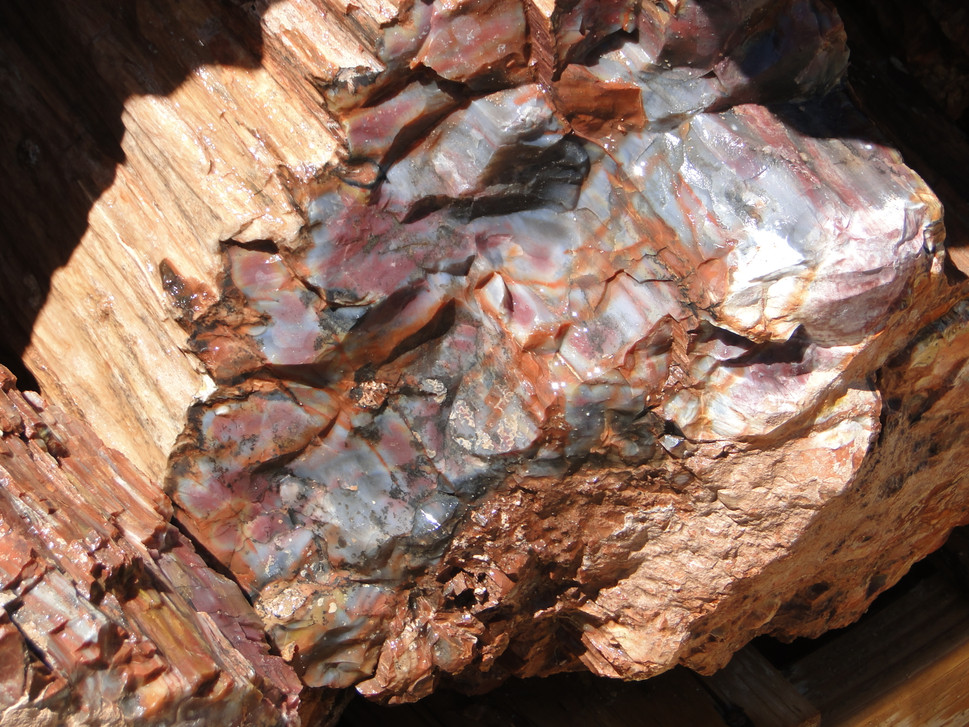Petrified Wood has been found in every state in the United States.
Petrified Wood is found worldwide in sedimentary beds ranging in age from the Devonian (about 390 million years ago), when woody plants first appeared on dry land, to nearly the present.
Petrification is the result of a tree or tree-like plants having been replaced by stone via a mineralization process that usually involves replacement. Petrified Forests tend to be either entire ecosystems buried by volcanic eruptions, in which trunks often remain in their growth positions, or a forest of trees moved by floods, before settling in one area and being buried in water and ash.
The organic materials decay and are replaced by minerals (mostly silica in the form of opal, chalcedony, or quartz) and in many instances, the original structure of the wood is retained.
The most notable large locations, many that are Petrified Forest and/or National Parks, are in the western parts of the United States. Areas in the eastern United States include a well-known site in the Catskills Mountains, near Albany, New York and the Mississippi Petrified Forest located near Flora, Mississippi.
Here is a list of the larger and more known sites in the Western United States:
Arizona- In northern Arizona lies one of the most well- known locations, the Petrified Forest National Park. Formed during the Triassic period (about 218-211 million years ago), in the Chinle Formation, the park is over 200,000 acres. In addition to petrified logs, fossils found in the park have included ferns, cycads, ginkgoes, and many other plants as well as fauna including giant reptiles called phytosaurs, large amphibians, and early dinosaurs.
California- During the Pliocene epoch (about 3.4 million years ago), what is now the Calistoga Petrified Forest, in Sonoma County, was formed when Mt. Saint Helens erupted. The Petrified Wood is mostly redwood trees, with just one pine tree found here.
Colorado- in the Florissant Fossil Beds National Monument, in Tiller County, and from the Eocene period (about 34 million years ago), there are large petrified Sequoia trunks, some still standing erect. Though many trees once grew here, only the Sequoias petrified!
Oregon- from the Pliocene Tertiary period, (5 million years ago), many petrified oak trees have been found along the Deschutes River. The Miocene epoch brought us some of the most beautiful petrified golden oak wood near Stinkingwater, Oregon. The McDermott Petrified Forest lies along 95 on the Nevada/Oregon state line, and there are several sites with several different types of trees.
Nevada- The Virgin Valley Petrified Forest is located in Humbolt County. Formed during the Miocene epoch (15 million years ago), this area is known for its opal wood!
Utah- Petrified Wood is mostly found around the Kanab area in the Triassic Chinle Formation (210-225 million years ago). At one time enormous trunks and branches were found on the surface here, but most of them have been collected and you really have to dig to find them.
Washington- The Gingko Petrified Forest (from the Miocene epoch about 15 million years ago) is in Vantage, Washington and it has produced a greater variety of trees (more than 200!), than any other Petrified Wood site worldwide.
Wyoming- Near Kemmerer is the Blue Forest in the Green River Formation from the Eocene Epoch (58 million years ago). About 25 miles away is the famous Eden Valley site. There is also a Petrified Forest in Yellowstone National Park, where there are many standing stumps. Sequoia is the primary species found, but sycamore, walnut, magnolia, chestnut, oak and maple have all been found here.
 US Dollar
US Dollar
 Australian Dollar
Australian Dollar
 Euro
Euro
 Canadian Dollar
Canadian Dollar
 British Pound Sterling
British Pound Sterling

